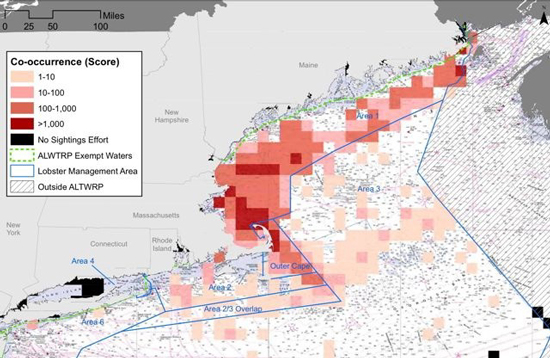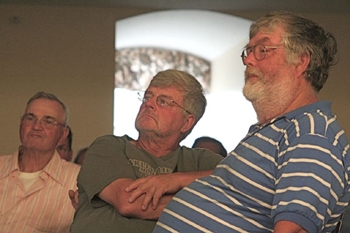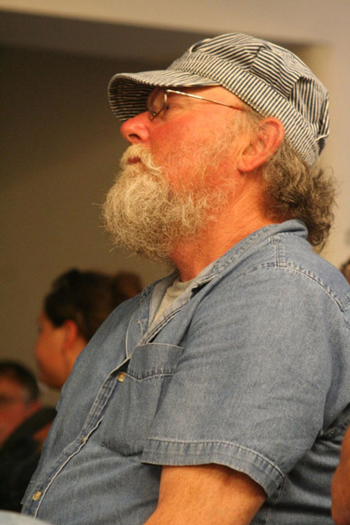Lobster Industry Whipped by NMFS Endlines Plan
by Laurie Schreiber

NOAA map
Lobster fishermen said that large whales rarely enter Maine’s waters, where the majority of their traps are located.
So they asked federal regulators to exempt them from any changes in the way they deploy their vertical lines, as long as the gear is located inside the state’s three-mile line.
About 60 fishermen appeared at a National Oceanic and Atmospheric Administration scoping session on vertical line risk reduction that was held in Ellsworth on July 12.
Dave Gouveia, supervisor of the Marine Mammal Program in the National Marine Fisheries Service’s(NMFS) Protected Resources Division, presented information for the development of a rule to reduce the risk of vertical lobster trap lines to endangered whales.
NMFS scheduled scoping meetings in July and August along the Northeast coast to discuss the development of a vertical line rule for the Atlantic Large Whale Take Reduction Plan.
According to information from NMFS, the plan was developed by the Atlantic Large Whale Take Reduction Team (ALWTRT), one of several take reduction teams established by NMFS to help develop plans to mitigate the risk to marine mammals—including right whales, humpbacks and fin whales—posed by fishing gear. The teams were established as advisory bodies under the Marine Mammal Protection Act (MMPA). These three species are also listed as endangered under the Endangered Species Act (ESA).
The team was established in 1996 and is composed of fishermen, scientists, conservationists, and state and federal officials.

Zone B Lobster Council chairman Jon Carter of Bar Harbor, center, was among about 60 fishermen who attended a scoping session in Ellsworth on endline risk reduction. Laurie Schreiber Photo
The plan, published in 1997, “was intended to be an evolving plan that would change as whale researchers learn more about the status of whale stocks and gain a clearer understanding of how and where entanglements occur,” according to NMFS information.
Gouveia said the thinking at NMFS is to move away from broad-scale, one-size-fits-all thinking and to customize any proposed action to specific areas. He presented a co-occurrence model developed by NMFS; the model combines whale sightings data and fishing gear data to identify areas where the two overlap.
“This approach will help NMFS develop a management scheme focused on smaller high-priority areas rather than a generic coast wide-scale broad approach,” according to the NMFS scoping document.
Gouveia said that NMFS is looking at two ways to reduce the risk of vertical line: reduce the number of lines, or find a way to make lines safer for whales. NMFS is primarily focused on the first approach, he said, but would welcome input from fishermen. He said that one approach to reduce the number of vertical lines will likely be to “trawl up” – that is, to increase the number of traps linked to one endline.
But the consensus among fishermen was that the so-called “whale-safe” rules, which most recently required the industry to switch from floating groundline to sinking groundline, would put the industry out of business.
“You show no value to human communities and what the decisions you make do to communities,” one man told Gouveia. “Everything is valued on the whale. None of us wants to hurt a whale, but you show no values to society.”
It’s been two years since the lobster industry made the switch from floating to sinking groundline to reduce entanglement risks to endangered large whales. Leroy Bridges of Deer Isle said the switch to sinking groundline has resulted in significant economic losses to the industry.

Leroy Bridges of Deer Isle is a former member of the Atlantic Large Whale Take Reduction Team. Laurie Schreiber Photo
“Do you people ever think about those losses, the economic impact that this fishery is sustaining?” Bridges said. “How come everyone in this room doesn’t think you people ever think about the actions you’ve taken, and now you’re asking for more?”
Bridges pointed out that just one vertical line in the entire Gulf of Maine will pose a risk for the endangered right whale. And, he said, that means the industry will always be targeted to change its fishing practices. The situation is made worse for the industry, he said, because no one really knows if any of the changes they’ve made to date have done anything to help the whales.
“The reality is, after this comes something else,” Bridges said.
Gouveia said the point was moot, because NMFS was required by federal law, in the form of the MMMPA and the ESA, to protect endangered species from human impacts. NMFS was required to proceed because whale entanglements with fishing gear continue to occur, he said.
According to the scoping document, in 2010, there were 25 confirmed entanglements: five right whales, 15 humpbacks, four minkes and one unknown whale. Eight whales were disentangled completely or partially, with what is believed to be non-life-threatening gear remaining. These included two right whales, one of which later died; three humpbacks and three minkes.
In 2011, as of June 9, there have been 15 confirmed entanglements. These include eight right whales, of which one was dead and four were in non-life-threatening situations; six humpbacks, and one minke, which was dead.
“I understand,” Bridges said. “But the economic times now, jobs are at a premium, and you’re asking for extreme sacrifice on the part of viable businesses. You’re worried about litigation.”
“You should be worried about litigation,” Gouveia responded.
“I’m worried about the federal government not doing its job,” said Bridges.
“It’s frustrating,” said Gouveia. “But that’s where we are. They’re endangered. Entanglements are still occurring. People are putting pressure on us.”
One man said that a better gear-marking system would make it easier to ascertain where the whales are getting entangled.
Fishermen expressed frustration with the loss of floating groundline when, they said, it was never certain that whales were getting entangled in it. Gouveia disagreed.
“We know that any float rope is a risk,” Gouveia said. “We don’t know if [switching to sinking line] cured the problem.” Gouveia said that NMFS has not set a target on the percentage of vertical lines to reduce.
“This is a radical approach,” he said. “We’re saying, ‘What can you feasibly do to reduce risk?’ And that would be the source of proposals to figure out what to do. We don’t know. The data isn’t good enough to tell us how much reduction is needed. It’s kind of arbitrary. So we’re saying, ‘What can you feasibly do – maybe trawling up or gear modification – to get your reduction of risk in your area? And we’ll see what we get….We’re trying to do things differently.” Gouveia said the government could not reverse the implementation of sinking groundline, even though, he said, the data is inadequate to determine its effectiveness for helping whales.
“We’ve lost our float rope,” one man said. “If we lose a bunch of endlines, we haven’t got s**t left to lose.”
“The last thing I want to do is put people out of business,” said Gouveia. “We can look at endlines and look at what we can easily do to avoid the disastrous stuff that occurred with the sinking groundline, and try to make it so it does make sense. Then we can move forward in a positive manner and try to minimize that, so the endlines are not as bad as it was with the sinking groundlines.”
Bridges and others asked for an adjustment of the existing exemption line out to the state’s three-mile line. The current exemption line, for groundline, runs nearshore, using the headlands as its seaward points.
Col. Joe Fessenden, chief of the Maine Marine Patrol, said the majority of fishermen fish inside state waters, where the co-occurrence model shows little overlap with the presence of whales. Shifting the exemption line further seaward to three miles, he said, would relieve the majority of fishermen of further changes.
Gouveia said the industry can propose an adjusted exemption line, but said the industry could be in for a fight, because conservation groups would like to see the exemption lines moved farther inshore.
One man wanted to know how NMFS would respond if the industry made changes to its endlines, whales still got snagged, and conservation groups threatened to sue the federal government if the lobster fishery were not shut down all together.
“We wouldn’t say, ‘Take all the gear out of the water.’ We would say, ‘Sue us,’” Gouveia responded.
“Then why not say that now?” the man asked.
“Because we’re not ready to do that,” Gouveia said.
“We are,” the man said.
Gouveia responded, “If you guys don’t want to do anything or feel that you should have that approach, you can. But that is not going to be the approach that we’re going to do, because we don’t feel that’s the right approach. I know it’s easy to say, ‘Let’s just draw a line in the sand and have the fisheries service defend us.’ It’s hard, because we have mandates that dictate what we do, and we’re not meeting that and we’re vulnerable.”
“You’ll still have a job. This will put us out of a job,” the man said.
Zone B Lobster Council chairman Jon Carter of Bar Harbor said that, while he appreciated the co-occurrence, area-specific approach taken by NMFS in this latest round of risk-reduction, there seemed to be a paradox for the industry: A rebounding whale population would also mean greater entanglement risks, no matter what the industry does. “We’re at the point where we almost can’t do any more,” Carter said.
Carter proposed that the industry should lobby legislators to change the MMPA.
“The marine mammal act obviously does not give a s**t about any of the fisheries, and maybe we can do something or they can change something,” Carter said. “Because we’re being driven by something that doesn’t care if we’re here. In this economy, we need people who are going to work, pay taxes and produce things, instead of people who are just going to live off the system. And we’re not the people living off the system, but we’re the ones getting kicked.”
Comments are due to NMFS by Sept. 12, and Maine’s proposal is due to NMFS by Sept. 30. The Atlantic Large Whale Take Reduction Team meets in January 2012 to review proposals. It is expected that NMFS will publish a proposed rule in 2013, followed by public hearings, with a final rule to be published in 2014.
Maine Lobstermen’s Association executive director Patrice McCarron invited fishermen to contact her (967-4555; fax (866) 407-3770; info@mainelobstermen.org or Sarah Cotnoir at the Department of Marine Resources sarah.cotnoir@maine.gov, 624-6596 with their ideas.
Stakeholders may submit comments at a scoping meeting, or by written comment via fax: (978) 281-9394; mail to: Mary Colligan, Assistant Regional Administrator for Protected Resources, National Marine Fisheries Service, 55 Great Republic Dr., Gloucester, MA 01930, Attn: ALWTRP Scoping; or e-mail: ALWTRPScoping.Comments@noaa.gov.
